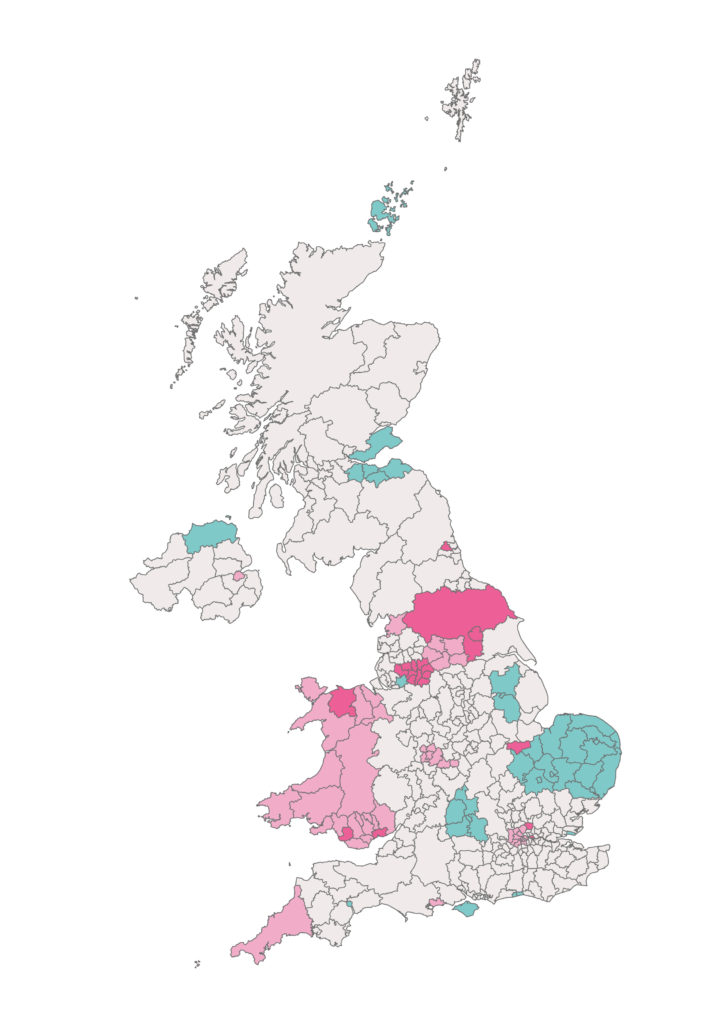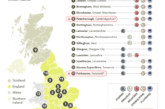
Four times as many local authorities are taking climate action by pursuing Local Area Energy Plans compared to two years ago, according to a new report by Energy Systems Catapult.
Sixty-six local councils (around one in 6) are working towards a Local Area Energy Plan (LAEPs) — recognised as the leading method for translating national Net Zero targets into local energy system action with collaborative, data-driven and cost-effective plans.
The new report Local Area Energy Planning: The Time and Place is Now provides an insight into how this innovative Net Zero approach is being utilised by local authorities to garner investment and deliver real locally led action. But the report doesn’t shy away from highlighting what more needs to be done to ensure a consistent and fair transition.
In less than two years the number of local councils working towards a Local Area Energy Plan to help shape Net Zero action has grown from less than 4% to over 16%. The 66 local councils include:
- Wales — all 22 local authorities in Wales
- Greater Manchester — 10 boroughs across the city
- York and North Yorkshire
- Cornwall & the Isles of Scilly
- Peterborough and Westminster
Pioneered by Energy Systems Catapult, with Innovate UK support, but now being delivered by a growing market of UK suppliers — LAEPs cover electricity, heat, and gas networks; future potential for hydrogen; building fabric and systems across domestic, commercial and industrial premises; energy system generation, storage and flexibility; and integration with energy infrastructure to decarbonise transport.
The new report by Energy Systems Catapult sets out how LAEPs are already delivering clarity for local places and communities on the projects, investment and innovations needed to reach a Net Zero energy system, such as: speeding up deployment of renewables, targeting building retrofit to reduce energy bills, getting homes heat pump ready and locating EV charging infrastructure to decarbonise transport.
This report also sets the recommendations needed to ensure the quality, consistency and momentum of LAEPs is maintained, and that confidence is given to the market to support continuing development:
- Recommendation 1 – LAEP Guidance should be adopted and endorsed nationally as the framework for place-based whole energy system decarbonisation planning. Informing other public funding and ensuring consistency across the UK.
- Recommendation 2 – Funding all areas to undertake a full LAEP, or as a minimum, whole energy system baselining (following Stages 1-3 of the LAEP guidance).
- Recommendation 3 – LAEP should be embedded within the National Planning Policy Framework, and future energy network institutional and governance arrangements to consistently align spatial and energy systems planning (as shown in Wales).
- Recommendation 4 – Establishing scope for consistent data inputs across the UK to ensure all plans are comparable, interoperable and easier to refresh and update.
- Recommendation 5 – Centralised support for local authorities to build LAEP capability and capacity.
Guy Newey, Chief Executive at Energy Systems Catapult, said: “The UK has made incredible progress in reducing carbon emissions by almost 50% since 1990 – mainly on the back of greening the electricity system.
“Success in the next phase of decarbonisation – focused on buildings and transport — will to a large extent depend on whether people and local communities support the major changes in how they get their energy.
“We will need to be much more sensitive to the particular characteristics of local areas. Local matters.
“To meet that challenge, Energy Systems Catapult, with support from Innovate UK and a number of pioneering local authorities and regional leaders, has been instrumental in developing the concept of Local Area Energy Planning over the past eight years.
“It is becoming a key tool for translating national Net Zero ambition into local action. LAEPs are already helping to inform investment, secure funding and foster collaboration.
“If we are to decarbonise our energy system effectively and at least cost, in a way that works for local areas, we need to accelerate Local Area Energy Planning now, and do it consistently nationwide. The time and the place is now.”

Dr Anna Stegman, Local Energy Transition Advisor and lead author, Energy Systems Catapult, commented: “Places are acting each day, many racing ahead with LAEPs whilst others are in danger of being left behind. This could lead to inefficient and uncoordinated investment in infrastructure and Net Zero project delivery which could drive up consumer bills.”
Andrew Clark, Place Business Leader at Energy Systems Catapult, said: “There is a huge urgency to act on Net Zero, a place-based approach is needed now. Local Area Energy Planning is designed to accelerate the journey to Net Zero in line with local priorities and deliver value for money.
“For example, in Wales, Local Area Energy Plans have been commissioned for all local areas across the country, that will scale up to create a National Energy Plan by 2024. A similar commitment to Local Area Energy Planning across all of the UK’s nations could play a huge role in clarifying local priorities and galvanising action, investment and innovation at local and regional level.
“Our recommendations in this report will go a long way to ensuring that success.”
Welsh Government, Lead for Local Area Energy Planning, Huw Lewis said: “The Welsh Government has committed to Net Zero by 2050. We recognise decarbonising our energy system will be fundamental to meeting net zero and are pleased to have partnered with Energy Systems Catapult to deliver our Local Area Energy Planning (LAEP) programme. The local energy plans will improve understanding of what the energy transition is likely to involve at a local level and will also inform our national policies and programmes as we work with partners to deliver an energy system fit for the future.
Greater Manchester Combined Authority, Director of Environment, Mark Atherton added: “The Local Area Energy Plan work undertaken is powerful because it identifies not just the type of technologies that will be needed for this transition, but their scale, indicative locations, and costs.”
City of York Council, Executive Member for Environment and Climate Change, Cllr Kate Ravilious, said: ”The [Local Area Energy Plan] will act as a blueprint for positive change in our city that directly benefits existing residents and businesses as well as future generations and will direct the strategy to secure the volume of inward investment we will need.”
Peterborough City Council, Executive Director: Place and Economy, Adrian Chapman said: “The Local Area Energy Plan (LAEP) has allowed us to understand the challenge of decarbonising our energy system and gives us a list of actions that build towards our net zero ambition in York. It has already provided evidence that helped secure funding, and is being used to help prioritise which projects will have the most impact and give the best value for money.”
Local Area Energy Planning is also gaining traction among policymakers in local, regional, and UK government, and is being referenced by Ofgem, by planners, and by energy network operators. A range of companies including Arup, Buro Happold, and City Science have begun delivering LAEPs in response to increasing demand.
You can download a copy of the report here.









